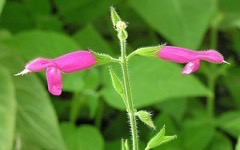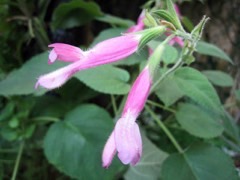 |
|
flickr.com/people/92252798@N07 |
 |
| flickr.com/people/52582306@N03 |
Translate this page:
Summary
Physical Characteristics

 Salvia dorisiana is an evergreen Perennial growing to 1.3 m (4ft 3in) by 1.3 m (4ft 3in) at a fast rate.
Salvia dorisiana is an evergreen Perennial growing to 1.3 m (4ft 3in) by 1.3 m (4ft 3in) at a fast rate.
See above for USDA hardiness. It is hardy to UK zone 10. The flowers are pollinated by Hummingbirds.
It is noted for attracting wildlife.
Suitable for: light (sandy), medium (loamy) and heavy (clay) soils and prefers well-drained soil. Suitable pH: mildly acid, neutral and basic (mildly alkaline) soils. It can grow in semi-shade (light woodland) or no shade. It prefers moist soil.
UK Hardiness Map
US Hardiness Map
Synonyms
No synonyms are recorded for this name.
Plant Habitats
Edible Uses
Edible Parts: Flowers Leaves
Edible Uses: Condiment Tea
The leaves and flowers are intensely aromatic, with a fragrance of mixed fruits[301 ]. They are likened to a sweeter version of Pineapple Sage (Salvia elegans) and used as flavourings in salads, fruits salads, iced teas, fruit punches and salad dressings[301 ]. The large leaves make for an easy harvest for drying and storage. They are used to make flavourful tea [301, 317 ]. The dried leaves retain the fragrance and also make very lovely wreaths and potpourri.
References More on Edible Uses
Medicinal Uses
Plants For A Future can not take any responsibility for any adverse effects from the use of plants. Always seek advice from a professional before using a plant medicinally.
Skin
None Known
References More on Medicinal Uses
The Bookshop: Edible Plant Books
Our Latest books on Perennial Plants For Food Forests and Permaculture Gardens in paperback or digital formats.

Edible Tropical Plants
Food Forest Plants for Hotter Conditions: 250+ Plants For Tropical Food Forests & Permaculture Gardens.
More

Edible Temperate Plants
Plants for Your Food Forest: 500 Plants for Temperate Food Forests & Permaculture Gardens.
More

More Books
PFAF have eight books available in paperback and digital formats. Browse the shop for more information.
Shop Now
Other Uses
Cosmetic Pot-pourri
An extract of the leaves is used as an ingredient in commercial cosmetic preparations as a skin conditioner[1243]. The dried leaves retain the fragrance and also make very lovely wreaths and potpourri. Scented. Ornamental. Deer Resistant. Attracts Wildlife, including Bees, Butterflies, and Hummingbirds. Flowers are Showy and Fragrant.
Special Uses
Attracts Wildlife Food Forest Scented Plants
References More on Other Uses
Cultivation details
Fruity sage succeeds in a range of soils but prefers to grow in moist, well-draining soil with rich, sandy loam. It will tolerate partial shade, but like most salvias, fruity sage prefers full sun. PH 6.1 (mildly acidic) to 7 (mildly alkaline). A plant of the tropics, where it is usually found at elevations between 1,000 - 2,500 metres. Plants do not grow well if the temperature falls below about 5°c for anything other than a short period, though they can withstand occasional short periods down to -2°c [200, 678 ]. The plant can be cut back to the ground in cold weather and usually resprouts from the base [678 ]. It dislikes dry soils [678 ]. Practically the whole plant is covered with hairs that release a delightful pineapple-grapefruit scent when stroked[678 ]. Plants can be cut back quite severely to encourage new growth[678 ]. Suitable as an Annual.
References Carbon Farming Information and Carbon Sequestration Information
Temperature Converter
Type a value in the Celsius field to convert the value to Fahrenheit:
Fahrenheit:
The PFAF Bookshop
Plants For A Future have a number of books available in paperback and digital form. Book titles include Edible Plants, Edible Perennials, Edible Trees,Edible Shrubs, Woodland Gardening, and Temperate Food Forest Plants. Our new book is Food Forest Plants For Hotter Conditions (Tropical and Sub-Tropical).
Shop Now
Plant Propagation
Seed, Cuttings (easy).
Other Names
If available other names are mentioned here
Peach sage, Fruit Sage, Fruity Sage, Fruit-Scented Sage, Fruit Scented Sage, Fruit cocktail sage, grapefruit sage
Native Plant Search
Search over 900 plants ideal for food forests and permaculture gardens. Filter to search native plants to your area. The plants selected are the plants in our book 'Plants For Your Food Forest: 500 Plants for Temperate Food Forests and Permaculture Gardens, as well as plants chosen for our forthcoming related books for Tropical/Hot Wet Climates and Mediterranean/Hot Dry Climates. Native Plant Search
Found In
Countries where the plant has been found are listed here if the information is available
Australia, Central America, Honduras (native), North America, Tasmania, USA inc. California.
Weed Potential
Right plant wrong place. We are currently updating this section.
Please note that a plant may be invasive in one area but may not in your area so it’s worth checking.
None Known
Conservation Status
IUCN Red List of Threatened Plants Status : Not Listed.

| Related Plants
|
| Latin Name | Common Name | Habit | Height | Hardiness | Growth | Soil | Shade | Moisture | Edible | Medicinal | Other |
| Cistus salviifolius | Rock Rose, Salvia cistus, Sage Leaf Rock Rose | Shrub | 0.6 |
8-11
| F | LM | N | DM | 1 | 0 | 3 |
| Salvia apiana | White Sage, Compact white sage | Perennial | 3.0 |
7-10
| | LM | N | DM | 3 | 1 | 2 |
| Salvia ballotaeflora | | Annual | 0.0 |
-
| | LM | N | DM | 1 | 0 | |
| Salvia carduacea | Thistle Sage | Annual/Perennial | 0.7 |
7-10
| | LM | N | DM | 2 | 0 | |
| Salvia carnosa | Purple Sage | Shrub | 0.8 |
6-9
| | LM | N | DM | 1 | 2 | |
| Salvia clevelandii | Blue Sage, Fragrant sage, Chaparral Sage | Shrub | 0.6 |
8-11
| M | LM | N | DM | 1 | 0 | |
| Salvia columbariae | Chia, Ziegler's sage | Annual/Perennial | 0.7 |
6-9
| | LM | N | DM | 3 | 2 | |
| Salvia elegans | Pineapple Sage, Pineapple-scented Sage, | Perennial | 1.0 |
8-11
| M | LM | N | DM | 3 | 1 | 2 |
| Salvia fruticosa | Greek Sage, Greek oregano | Shrub | 1.0 |
8-11
| | LM | N | DM | 2 | 3 | 2 |
| Salvia glabrescens | | Perennial | 0.3 |
-
| | LM | SN | DM | 1 | 0 | |
| Salvia glutinosa | Jupiter's Distaff, Sticky Sage | Perennial | 1.2 |
4-8
| | LM | SN | DM | 1 | 0 | 3 |
| Salvia hispanica | Mexican Chia, Chia | Annual | 1.0 |
8-11
| | LM | N | DM | 3 | 0 | |
| Salvia japonica | | Perennial | 0.8 |
7-10
| | LM | SN | DM | 1 | 0 | 2 |
| Salvia lanata | | Perennial | 0.3 |
6-9
| | LM | N | DM | 1 | 1 | |
| Salvia lanigera | Wrinkle-Leaved Sage | Shrub | 0.0 |
-
| | LM | N | DM | 1 | 0 | |
| Salvia lavandulifolia | Spanish Sage | Shrub | 0.3 |
4-8
| | LM | N | DM | 2 | 3 | 2 |
| Salvia leucantha | Mexican Bush Sage | Shrub | 1.2 |
8-10
| F | LMH | N | M | 0 | 1 | 3 |
| Salvia lyrata | Cancer Weed, Lyreleaf Sage | Perennial | 0.6 |
4-9
| M | LM | N | DM | 0 | 2 | 0 |
| Salvia mellifera | Californian Black Sage | Shrub | 2.0 |
7-10
| | LM | N | DM | 1 | 2 | |
| Salvia microphylla | Blackcurrant Sage | Perennial | 1.2 |
7-10
| | LM | N | DM | 2 | 2 | |
| Salvia moorcroftiana | | Perennial | 0.9 |
6-9
| | LM | N | DM | 1 | 1 | |
| Salvia multicaulis | | Shrub | 0.3 |
7-10
| | LM | N | DM | 1 | 0 | |
| Salvia multiorrhiza | Dan Shen | Perennial | 0.6 |
5-9
| | LM | N | DM | 0 | 3 | |
| Salvia officinalis | Sage, Kitchen sage, Small Leaf Sage, Garden Sage | Shrub | 0.6 |
5-10
| M | LM | N | DM | 4 | 5 | 5 |
| Salvia plebeia | | Biennial | 0.5 |
-
| | LM | N | MWe | 1 | 1 | |
| Salvia pomifera | Apple Sage | Shrub | 1.0 |
7-10
| | LM | N | DM | 2 | 2 | |
| Salvia pratensis | Meadow Clary, Introduced sage | Perennial | 1.0 |
3-7
| | LM | N | DM | 1 | 0 | 0 |
| Salvia reflexa | Mintweed, Lanceleaf sage | Annual | 0.8 |
0-0
| | LM | N | DM | 1 | 0 | 0 |
| Salvia sclarea | Clary, Europe sage, Clary Sage | Biennial/Perennial | 1.0 |
5-9
| M | LMH | N | DM | 2 | 2 | 3 |
|
|
Growth: S = slow M = medium F = fast. Soil: L = light (sandy) M = medium H = heavy (clay). pH: A = acid N = neutral B = basic (alkaline). Shade: F = full shade S = semi-shade N = no shade. Moisture: D = dry M = Moist We = wet Wa = water.

Expert comment
Author
Standl.
Botanical References
Links / References
For a list of references used on this page please go here
A special thanks to Ken Fern for some of the information used on this page.
Readers comment
| Add a comment |
|
If you have important information about this plant that may help other users please add a comment or link below. Only comments or links that are felt to be directly relevant to a plant will be included. If you think a comment/link or information contained on this page is inaccurate or misleading we would welcome your feedback at [email protected]. If you have questions about a plant please use the Forum on this website as we do not have the resources to answer questions ourselves.
* Please note: the comments by website users are not necessarily those held by PFAF and may give misleading or inaccurate information.
To leave a comment please Register or login here All comments need to be approved so will not appear immediately.
|
Subject : Salvia dorisiana
|
|
|
|